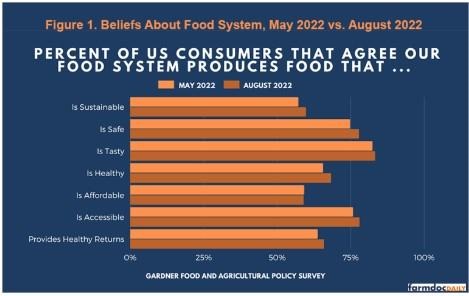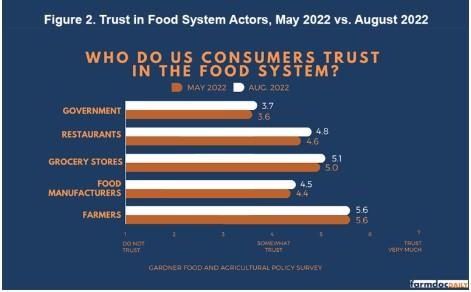By Jonathan Coppess and Maria Kalaitzandonakes
Department of Agricultural and Consumer Economics
University of Illinois
Brenna Ellison
Department of Agricultural Economics
Purdue University
This year, the Gardner Agriculture Policy Program launched the Gardner Food and Agricultural Policy Survey, a reoccurring survey of approximately 1,000 US consumers meant to monitor public opinion on food and agricultural issues (farmdoc daily, June 2, 2022).
The survey is fielded on a quarterly basis, and new respondents are recruited each quarter to match the US population in terms of gender, age, income, and geographic region. The survey includes several base questions, to allow us to track changes in public perception of agricultural issues, and several ad hoc questions meant to address timely issues relevant to agriculture and food policy. Quarter 1 was conducted in May 2022 and Quarter 2 was conducted in August 2022. In this post, we follow up on how US consumers’ beliefs about the food system and trust in food system actors have changed from May 2022 to August 2022.
Beliefs About the Food System
We asked participants to what extent they agree or disagree that the food system produces food sustainably, that is safe to eat, that tastes good, that is healthy, that is affordable, that is accessible, and in a manner that provides healthy returns for supply chain actors (e.g., farmers, manufacturers, grocery stores). Figure 1 shows the results for each food belief for Quarter 1 (May 2022) and Quarter 2 (August 2022).

In Quarter 2, we find that beliefs about the food system remained consistently high. We find that the majority of those surveyed either somewhat agreed or strongly agreed that the food system produces food that is sustainable (59.7%), safe (77.7%), tasty (83.2%), healthy (68.2%), affordable (58.9%), and accessible (77.9%) and that the food system produces food that provides healthy returns for supply chain actors (65.8%). Affordability received the lowest level of agreement, in line with continuing inflation concerns. However, we see little change in the proportion of Americans who believe their food is affordable between May 2022 (59.1%) and August 2022 (58.9%). In this quarter’s panel, we explored inflation issues further and will publish the results in future articles.
Trust in the Food System
We also asked participants to what extent they trusted food system actors, including the government, restaurants, grocery stores, food manufacturers, and farmers. Trust was measured on a scale from 1 (meaning they do not trust this group) to 7 (meaning they trust this group very much). Figure 2 shows the results for each food system actor for Quarter 1 (May 2022) and Quarter 2 (August 2022).
In Quarter 2, we find that trust in food system actors remained very consistent. In August 2022, farmers remained the highest trusted group (5.6) followed by grocery stores (5.1), restaurants (4.8), food manufacturers (4.5), and government (3.7).

Concluding Thoughts
Results from the 2nd quarter panel of the Gardner Food and Agricultural Policy Survey show that confidence in the ability of the US food system remained consistent between May 2022 and August 2022. We find that a strong majority of Americans continue to believe the food system produces food that is sustainable, safe, tasty, healthy, affordable, accessible, and provides healthy returns to supply chain participants. Among these, issues of affordability remain the lowest and will be explored further. Trust in food actors also remained very consistent, with farmers continuing to be the most trusted group. Future articles on this 2nd quarter panel will look closer at inflation issues, as well as conservation and climate change.
Source : illinois.edu